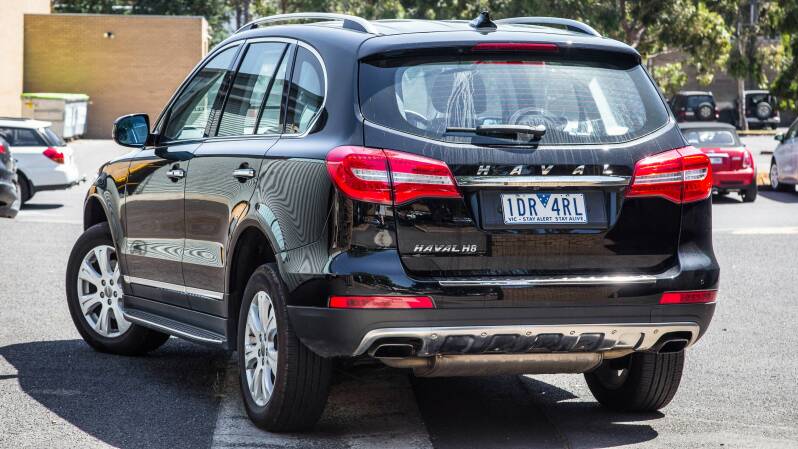


Haval is an automotive marque owned by the Chinese automaker Great Wall Motors that specialises in crossovers and SUVs. It was launched in March 2013 as an independant label. The haval brands exists since 2002.
While its entire model line initially carried the same badge, the company planned around 2010 to differentiate its SUV, passenger car, and pick-up truck offerings naming them Haval, Voleex and Wingle respectively. This goal may not have seen full fruition as compact cars carry the Great Wall badge as late as 2016. However, SUVs have been branded as Havals since 2013. Great Wall recognizes this on its website stating that in March 2013, "The Haval brand became independent officially, bringing GWM into an era of dual brand of Haval and Great Wall." In 2020, it was reported that the firm would not be selling Great Wall branded passenger cars anymore (at least in certain international markets) as all their SUVs would carry the Haval name, whilst their pick-ups, including the replacement for the Great Wall Steed (known as the Model P/Poer/Cannon ute), will be branded under the GWM marque.
h1

2012-2014


2014-2021

The Haval H1 or formerly the Great Wall Haval M4 is a subcompact SUV produced by the Chinese manufacturer Great Wall. It was essentially a rebadged and lifted Great Wall Florid, until the second generation which is a rebadged Great Wall Voleex C20R. The Great Wall Haval M4 was renamed to simply Haval H1 after Great Wall launched Haval into an individual sub-brand in 2013.
Based on the Great Wall Florid & Toyota Ist, the Great Wall Haval M4 has been launched on the Chinese car market in 2012. The Great Wall Haval M4 was launched in Malaysia in July 2014 as the Great Wall M4 with three variants available: Standard, Comfort and Premium. All three variants could be had with either a manual or automatic gearbox.[1] Early models were fully imported from China. Local assembly in Malaysia started in December 2014.
h6

2011-present

2017-present

2020-present

2015 coupé
The Haval H6 is a compact crossover SUV produced by the Chinese manufacturer Great Wall Motors under the Haval marque since 2011. It was introduced at the 2011 Shanghai Auto Show,[2] and it is a crossover, produced with both front-wheel-drive and four-wheel-drive drivetrain. It is the successor of the Great Wall Pegasus.
Originally named Great Wall Haval H6, it was later renamed the Haval H6 (and redesigned) for the newly developed the Haval brand. As of October 2015, the Haval H6 is the best selling SUV in China. It has been the best selling SUV every month in China for nearly two years.
The first generation H6 is powered by a 1.5 liter turbo engine producing 150hp or a 1.3 liter turbo engine producing 138hp. In the top trim level it can be equipped with high-strength body structure, front and side and curtain airbags. It uses components originating from renowned European and American manufacturers, such as Bosch (traction control), Delphi (diesel electronics), BorgWarner (four-wheel-drive system), and Honeywell (turbocharger).
In November 2015, the one millionth Haval H6 rolled off the production lines in the Tianjin plant, approximately four years and three months after its launch.

The third-generation Haval H6 has been launched in China and will offer cutting-edge tech and luxury equipment for mainstream prices when it arrives in Australia in the first half of 2021.
h8

2013-2018



The Haval H8 was previewed on the April 2012 Beijing Auto Show as the Great Wall Haval H7 concept, the production version was revealed on the Chinese car market during the 2013 Guangzhou Auto Show. Pricing of the Haval H8 SUV ranges from 183,800 to 231,800 yuan. The chassis of the H8 is a uni-body, while suspension in the front is double-wishbone independent with the rear being multi-link independent. Drive train options include both 4×2 and 4×4.
The Haval H8 is powered by a 2.0-litre turbo-petrol engine making 160kW at 5500rpm and 324Nm between 2000 and 4000rpm. The engine is mated to a ZF six-speed automatic gearbox. The torque is directed to the rear wheels by default, with a transfer case by Borg-Warner sending up to 50 per cent of torque to the front wheels when needed.
h9

2014-2019


2019-present

The Haval H9 is a full-size SUV produced by Haval, a sub-brand of Great Wall Motors debuted on the 2014 Beijing Auto Show and commenced production in November 2014.
The Haval H9 is the largest vehicle ever developed by Great Wall Motors with the drive train being a new all-wheel drive system, and is the second brand new SUV with a body-on-frame chassis developed by Haval, following the Haval H3 and Haval H5. It competes with the likes of the Toyota Land Cruiser Prado and Mitsubishi Pajero. The H9 is available in both 5-seater and 7-seater configurations.
Construction is a body-on-frame chassis underpinned with double-wishbone front suspension, and a multi-link solid axle at the rear. Initial H9's were powered by a turbocharged 2.0L I4 petrol engine with 214 hp.
An All-Terrain four-wheel-drive control system is available and modulates engine response between various modes including Auto, Snow, Sand, Mud and 4 Low.
The H9 was given a facelift for 2019 onwards consisting of a new front end as well as the rear spare tyre moved from the rear door to the bottom of the car.
h7

2018-present



2020 f7x
The Haval F7 is a compact sport utility vehicle produced by Great Wall Motors under the Haval marque since 2018.
The vehicle debuted on 29 August 2018 at the Moscow International Automobile Salon. In November 2018, it was in China in the trade. The Russian market is expected to follow in the spring of 2019. The vehicle is positioned above the Haval F5 and is based on the WEY VV6. Haval already had a first look at the SUV at Auto Shanghai in April 2017 with the concept car Haval HB-03.
Power of the F7 comes from a 2.0-litre turbocharged four-cylinder petrol engine developing 147kW and 345Nm. A 1.5-litre inline-4 engine is also offered. Power is sent to the front wheels through a seven-speed DCT with wet clutches developed by Great Wall Motor.
A fastback version of the Haval F7 called the Haval F7x debuted during the 2019 Shanghai Auto Show. The Haval F7x shares the same structures as the Haval F7, and all parts before the B-pillars are the same.
big dog





2020-present
The Haval Big Dog is a compact crossover SUV produced by the Chinese manufacturer Great Wall Motors under the Haval brand since 2020.
The name 'Big Dog' was chosen by the Chinese public in a poll written out by Haval. The body colors and trim levels are also named after dog breeds, starting from the entry 'Husky' trim level up to the top 'Belgian Shepherd' trim.
The Haval Big Dog is offered with both front-wheel-drive and four-wheel-drive drivetrain. Despite it is believed to be the successor of the Haval H5, the Big Dog is a crossover SUV built on the unibody Lemon platform shared with the third generation Haval H6 instead of a body-on-frame platform. The Big Dog uses a transversely mounted engine, and it uses McPherson suspension for the front axle and multi-link suspension for the rear axle.
In terms of engine and power, the Haval Big Dog will be powered by a 1.5 liter turbocharged engine code-named GW4B15A producing 169 horsepower or a 2.0 liter turbocharged engine code-named GW4N20 producing 211 horsepower. The 1.5 liter versions are front-wheel-drive while the 2.0 liter versions are four-wheel-drive. The Big Dog will also offer a variety of driving modes and off-road specifications and features such as two differential locks, tank U-turn, and Computer-controlled four-wheel drive.
jolion

2020-present



The Haval Jolion (meaning "first love") is a compact crossover SUV produced by Haval of Great Wall Motors from 2020.
The Haval Jolion was first shown at the 2020 Beijing Auto Show. The Chinese name pronounces "Chulian" and means "First Love" in Chinese, and it has a heart on its license plate. The Haval Jolion is based on the Lemon platform which also underpins the Haval Big Dog. The Haval Jolion has a 1.5-liter turbocharged engine that produces 156 horsepower and 220Nm. The Jolion also has a 7-speed robotic transmission and front-wheel drive. As of July 13th, 2021 three trim levels are available. Haval has positioned the Jolion as a lot of car for the money. It’s also worth mentioning here that the Jolion, much like the H6 before it, dispenses with traditional buttons and controls most features and functions through the touchscreen.
The entire Jolion range shares the same list of safety features, including seven airbags, including one between front seat occupants to reduce the risk of head-clash, and pretensioning seatbelts too. Stability and traction control with secondary collision mitigation is standard, as is tyre pressure monitoring.
x dog

2022=present



The Haval X Dog is an upcoming compact SUV to be produced by Chinese SUV manufacturer Haval, a marque of Great Wall Motors, starting 2022.
The Haval X Dog was first revealed as a concept at Auto Shanghai on April 21, 2021 in Shanghai, China. Two engine options are available for the X Dog—a 1.5L turbo 4-cylinder and a 2.0L turbo 4-cylinder—outputting 170 and 230 horsepower respectively. The Haval X Dog is one of those new Haval cars with an individual design. Not to everyone’s tastes, but it doesn’t have to be. The X Dog is marketed more as a statement than as a mass market car. It surely looks interesting. Very boxy, very Tonka, retro yet modern, and very massive. The Haval X Dog was noted for its unconventional steering wheel featuring a touchscreen in the center. Another four other touchscreens are also within the interior; a center infotainment system, the digital instrument cluster, a climate control screen on the center console, and small screen on the dashboard for the passenger side.



The company made appearances at the Dakar Rally previously. The idea was to re-launch the brand with their new line “Haval” in the Argentina-Chile Dakar Rally 2010, the hardest and most exigent automobilist race in the world (Dragon Dakar, 2011), showing that a Chinese SUV can accomplish all the requirements to compete in an extreme competition. In 2010, it first entered the race as car #389, with a modified model based on Haval H3, and ranked 33rd. The next year it finished 22nd as car #373. Its best rankings were achieved in the 2012 and 2013 editions, when the team finished 6th. At the 2014 edition, the team had been competing with the new Haval H8 model, and finished in 8th. Since 2015, the company decided to quit Dakar Rally, but kept participating in other domestic rally races.









Create Your Own Website With JouwWeb